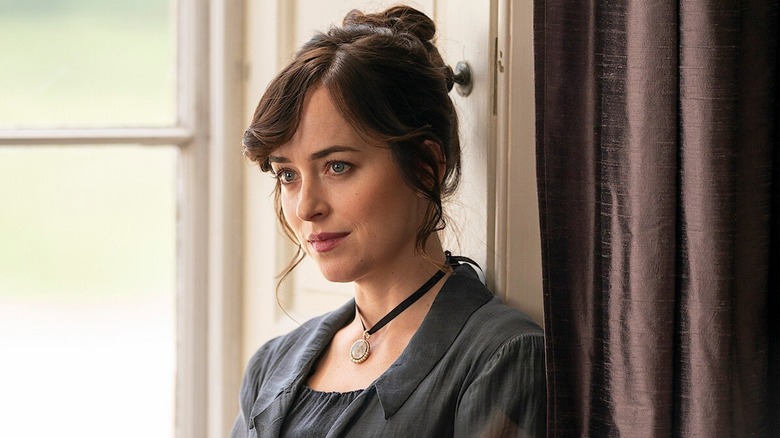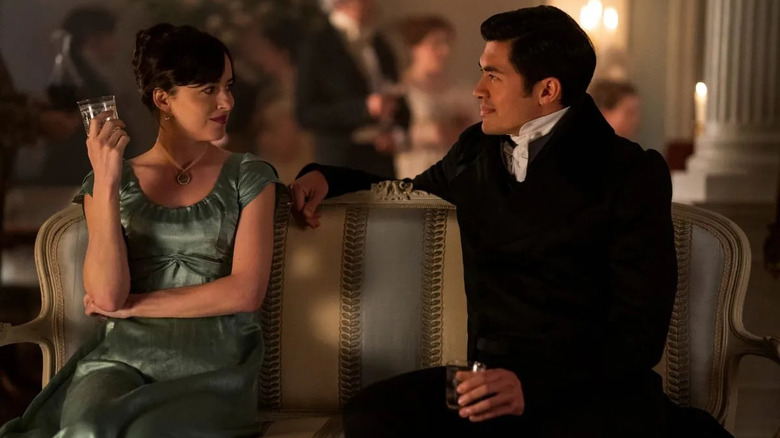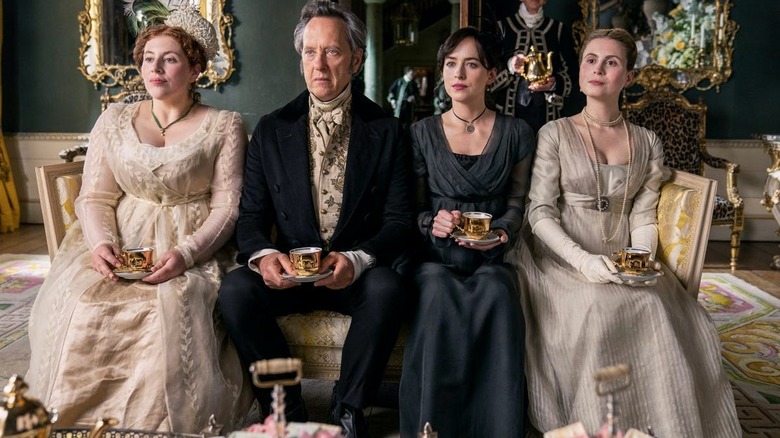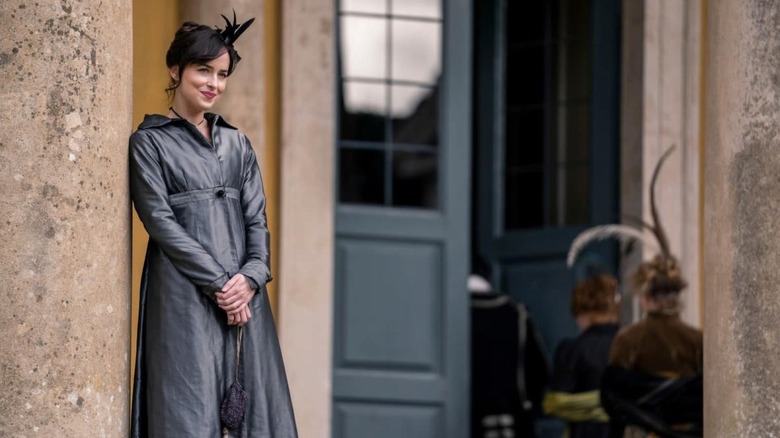How Persuasion Was Inspired By Real-Life Austen Family Drama
Much of what literary historians know about Jane Austen's personal life was gleaned from the author's many, many letters she wrote to friends and family. When author Deirdre La Faye collected many of Austen's letters in a volume (which is still in print), she found that only 161 letters remain out of what could have been thousands. According to David Nokes' 1998 biography "Jane Austen: A Life," Austen's sister Cassandra burned Jane's letters in the hopes of avoiding a scandal; evidently, Jane wrote some rather wicked, opinionated, and blunt things about her neighbors and family members that Cassandra would have preferred remain private.
Jane was to have described, in those missing letters, a great deal of unhappiness, drama, and sicknesses in the family — dramas darker and more serious than the marital disagreements and plummy, lightweight bickering seen in her novels. Jane herself passed away in 1817 at the age of 41 of what might have been Hodgkin's lymphoma or Addison's disease, leaving two of her six most celebrated novels to be published posthumously.
"Persuasion" (1818), one of Austen's posthumous novels, was recently adapted to film by director Carrie Cracknell and screenwriters Ronald Bass and Alice Victoria Winslow, and is currently available to stream on Netflix. Briefly, "Persuasion" is about Anne (Dakota Johnson), an unmarried woman of 27, who, when her prodigal father (Richard E. Grant) blows the family fortune and is forced to move everyone out of their estate, is reunited with an ex-fiancé, naval Captain Wentworth (Cosmo Jarvis). Anne nearly married Wentworth eight years earlier, but broke it off when she was persuaded that he wasn't of high enough station. Anne's conflict is whether or not to marry a man she seems to still love, or reject him because of his lack of social stature, a common concern in Austen novels.
The Fanny Knight connection
As it turns out, the plot of "Persuasion" may have been more than idle caprices of a genius author. Indeed, in about 1814, when Austen was writing "Persuasion," letters (edited by Sarah Chauncey Woolsey) revealed that Jane's niece, Fanny Knight, was going through something very similar to Anne.
Fanny, like Anne, was 27 and unmarried — something of a scandal in 1810s England. Jane seemed very impressed by Fanny, once writing to her:
"You are the paragon of all that is silly and sensible, commonplace and eccentric, sad and lively, provoking and interesting. Who can keep pace with the fluctuations of your fancy, the capprizios of your taste, the contradictions of your feelings? You are so odd, and all the time so perfectly natural!—so peculiar in yourself, and yet so like everybody else!"
Those familiar with Austen's work will see a great deal of the author's flowery descriptions of her supporting characters in that passage. Austen was enamored enough by Fanny to tell her about works in progress. In a letter dated Sunday, March 23, 1814, Austen described the still-in-the-works "Persuasion" modestly, saying merely that Fanny would like Anne (although drawing no direct parallels to Fanny's face):
"Do not be surprised at finding Uncle Henry acquainted with my having another ready for publication. I could not say No when he asked me, but he knows nothing more of it. You will not like it, so you need not be impatient. You may perhaps like the heroine, as she is almost too good for me."
Jane's romantic advice
It would be in a letter from November 18 of that same year that Jane would offer some actual romantic advice to Fanny, inviting some direct parallels to the fictional Anne. Anne wanted to marry for love, but was concerned with the social status of her potential groom. In the November 18 letter, Austen, responding to news of a potential suitor for Fanny, found that the potential husband was indeed marked by an appropriate social clout:
"His situation in life, family, friends, and, above all, his character, his uncommonly amiable mind, strict principles, just notions, good habits, all that you know so well how to value, all that is really of the first importance,—everything of this nature pleads his cause most strongly."
But in a letter from November 30, Austen was more explicit that Fanny should follow her heart, more than her head:
"When I consider how few young men you have yet seen much of, how capable you are (yes, I do still think you very capable) of being really in love, and how full of temptation the next six or seven years of your life will probably be (it is the very period of life for the strongest attachments to be formed),—I cannot wish you, with your present very cool feelings, to devote yourself in honor to him. It is very true that you never may attach another man his equal altogether; but if that other man has the power of attaching you more, he will be in your eyes the most perfect."
It's definitely worth noting that Fanny did end up marrying her beloved ... at age 27. Three years after Austen's death. Her full biography can be found on the Jane Austen website.
Inspiration for Wentworth?
The parallels between Austen's family and "Persuasion" don't end with Fanny. Charles Austen, Jane's younger brother, seems to have at least partially served as the inspiration for Wentworth, the hunky naval man. The Jane Austen Society of North America (JASNA) found interesting similarities between Wentworth and Charles that couldn't have been mere coincidence. JASNA pointed out that Charles, too, was a naval captain, and he went through an interesting marital tragedy of his own. At age 17, he married his first wife, Francis Palmer, and they had three children. Seven years into their marriage, Palmer died giving birth to their fourth child. The child also didn't survive.
Six years later, Charles would marry Palmer's sister, Harriet. This would be an illegal marriage, as it was against the law to marry your dead wife's sister at the time. After a 65-year struggle, the Deceased Wife's Sister's Marriage Act was finally passed into UK law in 1907.
In a fictional way, Austen seemed to be creating an ideal couple in the pages of "Persuasion" by pairing a fictionalized version of her younger brother (recovering from tragedy) with a fictionalized version of her niece, aging into her late 20s with no husband. In case it wasn't clear from her prose, Austen liked to see marriages and romances turn out for the best, often pairing people in handily perfect couplings.
The new Netflix film version of "Persuasion" is frothy and modern (there is a lot of breaking of the fourth wall), but it captures Austen's spirit well (even if the lead actors could have done with a little more chemistry — Jarvis is a horse in human form). Knowing the parallels between the source material and the life of the author, though, will have viewers watching the adaptation a little more deeply.



